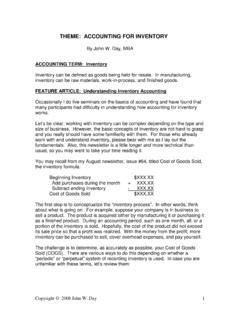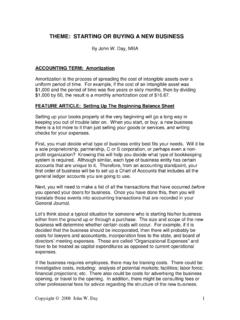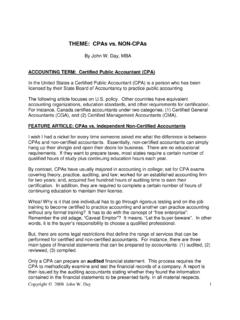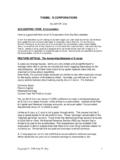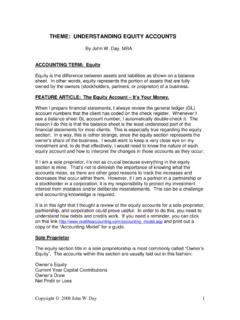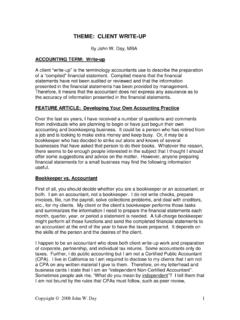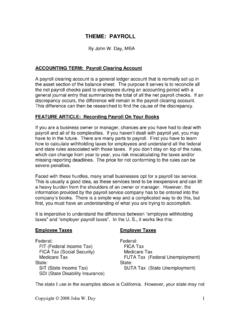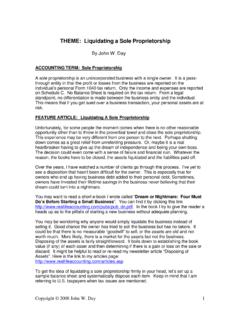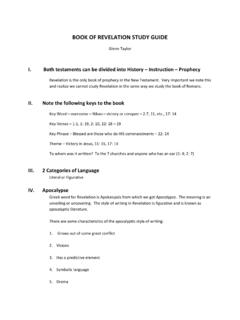Transcription of THEME: BUSINESS DISPOSITIONS - Online & E …
1 Copyright 2008 John W. Day 1 THEME: BUSINESS DISPOSITIONS By John W. Day, MBA ACCOUNTING TERM: Capital Asset For accounting purposes, a capital asset is property purchased for use in production over long periods of time rather than for resale. For ( ) federal income tax purposes, a capital asset is defined as all property owned except: Property held for resale or property that will physically become part of merchandise for sale Accounts Receivable Depreciable property used in a trade or BUSINESS Certain copyrights, literature, musical or artistic compositions or similar property Certain Government publications (This definition is a direct quote from the Small BUSINESS Quickfinder Handbook, 2003 Edition, page L-15. You can find this book at It is an excellent resource.) FEATURE ARTICLE: disposition Of A Sole Proprietorship Out of all the accounting work I do, BUSINESS DISPOSITIONS are some of the most challenging.
2 Why? Because they can become so very complicated! Disposing of a BUSINESS can come as a result of a sale or exchange, death of a partner, liquidation or dissolution. Naturally, some DISPOSITIONS are easier to process than others, such as sole proprietorships and stock sales of corporate stockholders. It s the pass-through entities that can be difficult, and that depends on how complex they have become. This is a broad subject that has many variables depending on the circumstances. However, in this limited space, I would like to share some general ideas regarding the steps that must be taken to record properly the disposition transactions and hint at some of the tax ramifications. Sole Proprietorships There are different types of sole proprietor DISPOSITIONS . You could just be calling it quits, which means you could sell off what you can and store the remaining assets in your garage.
3 Or, you may have found a buyer and are selling the entire BUSINESS . In this case, you will probably be required by the Uniform Commercial Code (UCC) of your state to do what is called a bulk sale agreement . Many countries outside the also require this sort of thing. Copyright 2008 John W. Day 2 Usually, the seller is required to: 1) publish a notice of the sale; 2) give written notice to all creditors; and, 3) set up an escrow of the funds realized from the sale upon which the creditors can make a claim for a brief period of time. These statutes are intended to prevent a merchant from quietly selling his/her BUSINESS inventory and disappearing without paying current creditors. Regardless of the type of disposition for a sole proprietorship, all assets sold or discarded must have a value placed on them in order to determine the gain or loss on the disposition . (Review my article Disposing of Assets for the mechanics of figuring gain or loss.
4 The reason this step is so important is that the amount of income tax you pay is predicated on the results of your calculations. Concurrently, the buyer has to record the value of the different assets purchased on his/her books. These values are critical to the buyer because fixed asset depreciation schedules and certain amortization schedules may have to be established. Some of your assets may be capital assets and some may not. Review the definition above. This means that some of your assets sold may be taxed at ordinary income rates and some at capital gain rates. Currently, tax law gives favorable treatment for capital gains over ordinary income items. The tax forms that cover these areas are Schedule D for capital gains, and Form 4797 Sale of BUSINESS Property, for assets used in the BUSINESS that have been capitalized and depreciated. Basically, you are going to record the same information on these forms, as you have in your journal entries.
5 Let s say you just sold your small sole proprietor BUSINESS . Where do you begin? First, make a list of your assets that are being sold. Second, establish a cost basis for each asset. Third, determine the fair market value for each asset. Fourth, compare the selling price of the BUSINESS with the sum total of fair market value of all the assets. If the selling price is higher than the sum total of assets, then the difference should be construed as goodwill . Fifth, calculate the gain or loss from each asset sold. With the information gleaned from these five steps, you can create a list of assets sold with their respective selling price to be included in the bulk sale agreement, and prepare Schedule D and form 4797 Sale of BUSINESS Property for your own personal tax return (if you live in the ) QUESTION: How Are Corporations And Partnerships Disposed Of? By far, the easiest disposition of a BUSINESS asset occurs when a stockholder sells his/her stock.
6 All that is needed is the name of the stock, the number of shares, the date the stock was purchased and sold, the purchase price, and the sale price. This information is entered on Schedule D of the 1040 personal tax return to determine whether there was a short or long-term capital gain or loss. No big deal! Copyright 2008 John W. Day 3 C-Corporations But, what if you own a small corporation that you are selling, and the buyer does not want your corporate entity? Perhaps the buyer simply wants to purchase some of your assets. Okay, no problem. You sell those assets and journalize the gain or loss as you would for any disposition of an asset. But, you want to quit the BUSINESS , so you must liquidate the corporation, or, in other words, shut it down. The remaining assets must be distributed to the stockholder/s. At this point, you will want to consult with your accountant to figure out if there is a taxable gain to the corporation.
7 This is because a corporation recognizes gain or loss on the distribution of property as if the property were sold to the distributee at fair market value. You will write journal entries removing all assets and liabilities to dividends. For example: DESCRIPTION DEBIT CREDIT Dividends 20,000 Accounts Receivable 6,000 Cash 4,000 Goodwill 10,000 DESCRIPTION DEBIT CREDIT Notes Payable 2,000 Accounts Payable 500 Dividends 2,500 If the stockholder receiving the liquidating dividend assumes responsibility for the liabilities, then that amount is added to his/her stock basis. It s up to the stockholder to be able to prove stock basis. For accounting purposes, you must write a series of journal entries that reduce the balance sheet to zero by distributing all the assets and liabilities to the stockholder. Even the common stock and paid-in-capital is distributed to the stockholder.
8 For example: DESCRIPTION DEBIT CREDIT Dividends 50,000 Common Stock 25,000 Paid-in-Capital 25,000 I reiterate, consult your accountant, because there may be other variables that affect how the liquidation process is conducted. The federal requirements for corporate liquidations are filing a Form 966 Corporate Dissolution or Liquidation , along with a certified copy of the plan of liquidation with the Internal Copyright 2008 John W. Day 4 Revenue Service within thirty days after the adoption of the plan of liquidation. You should also check with your state for their filing requirements. Pass-through Entities Pass-through entities, you may recall, are Partnerships, Limited Liability Companies taxed as partnerships, S-Corporations, or certain types of Trusts, where the profit or loss generated by the entity is passed through to the owner/s. The thing to remember is that in a sale or exchange of interest in a pass-through entity all the assets being sold are considered.
9 This means that various tax rates may apply. It s the same concept mentioned above regarding the sale of specific types of assets. The tricky part is accurately determining the partner s, member s, or stockholder s basis in the assets being sold. This is where it can become quite complicated. Partners or stockholders may have contributed property other than cash that has appreciated. Calculations must be made to determine what each partner s share in the BUSINESS is and apply that percentage to the assets being sold. There are a multitude of special rules that may apply. Unless you are very sure of what you are doing, I strongly urge you to seek professional help. After all, not many people understand the tax implications of hot assets, disproportionate distributions, or any of the other esoteric things that can befall the seller of a BUSINESS interest. As I said before, all I can do is to alert you that there are many things to consider when disposing of a BUSINESS .
10 You can t just sell the BUSINESS , put the money in your pocket and walk away. Let your accountant know what is going on before you sell. There may be tax considerations that affect your decision-making. TIP: A Risky Way To Sell A BUSINESS Here is some good advice. Don t sell your nice little BUSINESS on an installment basis, unless you have some good collateral outside of the BUSINESS . Some BUSINESS owners are so anxious to sell their BUSINESS that they are willing to carry a note from the buyer. Sometimes this arrangement works out, but often it doesn t. It is not worth the risk, unless you know and trust the buyer personally, as if he/she were a long-term employee, etc. The problem arises when the buyer can t make the BUSINESS work, runs it into the ground, can t make his/her payments to you, and gives the BUSINESS back. The last thing you wanted to do is to have to come out of retirement and build the BUSINESS up again.
